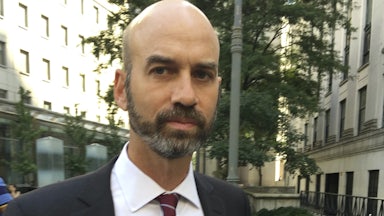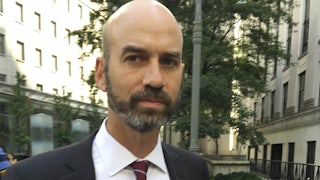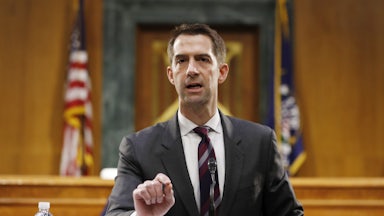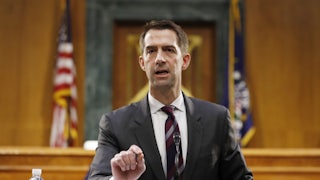On Friday, both sides in Sarah Palin’s defamation suit against The New York Times rested, leaving the former Alaska governor to rue the testimony she offered a day earlier, which appeared to undercut her case in inevitable, hilarious, Palinesque fashion. How the jury weighs her performance may factor heavily into the trial’s outcome. In short order, we will know whether Palin flubbed her big opportunity on the stand, torpedoing the case against the paper. But we know right now that she more than capably accomplished another goal: thrusting herself back into the news cycle after a long period of mere intermittent attention.
The former Republican vice-presidential candidate had brought a suit against the paper alleging that she had been defamed by a (quickly corrected) 2017 editorial originally drafted by editorial board member Elizabeth Williamson and edited by James Bennet, who was the editor of the opinion page at the time.
The published piece alleged without evidence that an image posted by her super PAC in 2010 had “incited” the mass shooting that severely wounded then-Congresswoman Gabby Giffords. The language that ran afoul of Palin, notably, wasn’t included in Williamson’s original draft. Rather, it was added by Bennet in what appears to have been a hasty attempt to sharpen Williamson’s work with a dose of “both-sides” journalism.
That Palin managed to identify a shoddy bit of work was never really in doubt. The trial has been a gut-check moment for journalists, who have watched the proceedings with what The Washington Post’s Margaret Sullivan characterized as “existential dread.” While the editorial process that led to the piece in question may have been especially slapdash, mistakes are common enough occurrences in journalism that one wouldn’t be thought a fool to wonder, “There but for the grace of God (or sound editorial practices) go I.”
Still, it was up to Palin to offer the jury some convincing proof that her claim satisfied the statutory demands for defamation. For what it’s worth, she got off to a nice start. Taking the stand, Palin testified that the Times’ assertion that she had been responsible for a mass shooting had affected her deeply—one girl who was killed, she noted, was the same age as her daughter Piper. She told the court that the editorial itself caused her trouble sleeping—even if she struggled to come up with ways in which it had harmed her materially. Her political career was, in 2017, all but over. By then, Donald Trump had long since stolen her brand and she was an afterthought.
Palin acknowledged as much on the stand, forthrightly noting that by 2017, she was past her prime. “I didn’t have the PAC up and running and being aggressive,” she said. “I didn’t have any TV contracts. I didn’t have that platform,” she added, referring to herself as David to the Times’ sinister Goliath. It was in some ways a sad diminution of her triumphant emergence in 2008 on the national stage, when she pitched herself as a no-nonsense “hockey mom” from Alaska, calling B.S. on a political establishment that looked down its nose at people like her.
But times had changed: “There I was up in Wasilla, Alaska,” she said, “going up against those who buy ink by the barrel, and I had my No. 2 pencil on my kitchen table.” It was a classic Palin line—framing herself as an underdog taking on an evil elite—but a far cry from the kind of swashbuckling language she used when she first hit the political mainstream. The fact that Palin had come out of nowhere was always key to her political appeal; now she was stuck there.
Whatever momentum she’d managed at the top of her testimony swiftly eluded her as it continued. Under questioning from her own attorney, Palin alleged that The New York Times had libeled her in instances aside from the 2017 editorial. Specifically, Palin said those close to her knew they would “respond again to what The New York Times had lied about again.” Pressed on that point, however, Palin came up short on providing concrete examples of wrongdoing: “My view was The New York Times took a lot of liberties and wasn’t always truthful,” she said, adding, “That’s what I meant by ‘again.’”
Later, when a lawyer from the Times brought up The Masked Singer, the quasi–game show that she appeared on in 2020, Palin replied, “Objection.” She drew a reminder from the judge that witnesses were not permitted to object, as well as titters from those assembled in the courtroom.
That might have been the moment that doomed Palin’s suit. Palin’s evidence-free assertions probably would have served her in good stead on the campaign trail or the debate stage, but in this setting, it was a self-inflicted wound. “No one who has even casually followed the former governor’s career would be surprised at these specifics-free blasts against the media,” wrote The Washington Post’s Erik Wemple. “Yet this time, Palin chose the wrong venue for such a critique. Adoring audiences at Fox News don’t stop and ask for citations, specifics, supporting evidence. But that’s precisely what happens in a courtroom.”
But there are other remedies outside of the courtroom that Palin may yet obtain, and these might be prizes she’ll cherish having after spending such a long time out of sight and out of mind. Palin’s struggle in this regard has been somewhat surprising in light of the fact that she’s played an outsize role in pushing the Republican Party toward its current monstrous iteration. Right-wing politics has never been more Palin-shaped than it is right now; former President Donald Trump has somehow obtained all the credit for a derivative brand that Palin, for all her faults, at least came to honestly. But Palin has been left behind, largely relegated to tabloid stories and spectacle-driven reality television for washed-up “celebrities” like Dancing With the Stars (where she appeared to cheer on her daughter Bristol) and The Masked Singer.
What Palin hasn’t possessed in recent years is what passes for the real coin of the realm on the American right: a hot, shiny, simmering grievance with the titans of the mainstream media. Palin v. New York Times is, essentially, her latest appearance on a game show—an attempt to thrust herself back into the spotlight, this time with a hook that might lead to a career revival. The outcome of the trial was never the point. Palin can credibly return to her favorite hobbyhorse: the lamestream media as her persecutor.
Should she succeed, she may well ascend to the high levels of right-wing fame she once enjoyed. But the opportunity to fail and once again become a martyr to the depredations of elites, is a decent enough consolation prize. Palin has always been best as an underdog fighting back against forces more powerful than herself. The assertions she made on the stand, implying examples of a multitude of wrongs beyond the Bennet editorial that the Times had meted out, none of which she could actually call to mind, demonstrated that she’s not actually there to fight for the truth. She’s there to make sure that the people who matter—right-wing cable news bookers—start remembering her again and rescue her from the outcast state to which she so ably testified. The verdict was never the point: What mattered was the stature of her opponent. This was the Gray Lady versus the GOP’s forgotten Norma Desmond, fighting for lost relevance, testifying that she’s still big—it’s the media controversies that got small.










